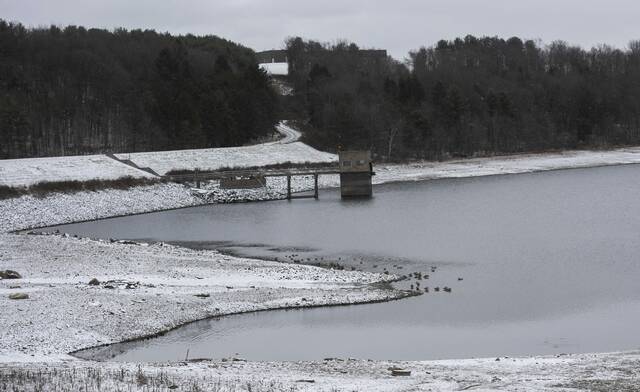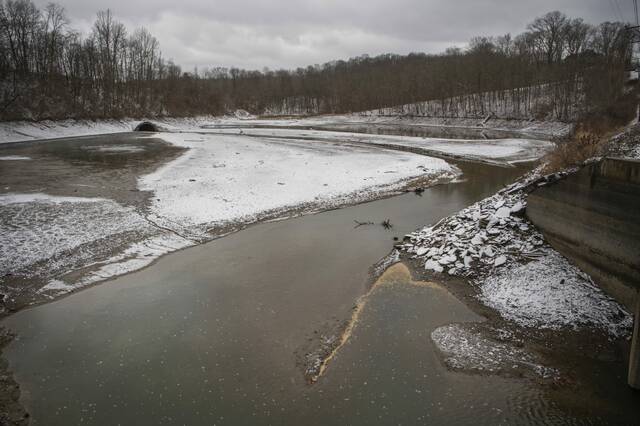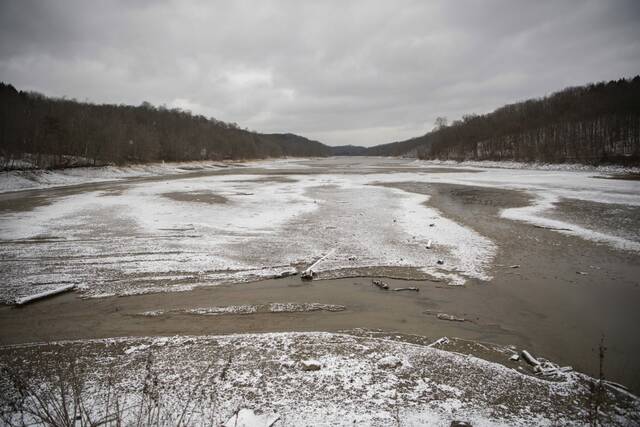Shrinking resource: Customers heed conservation order but Beaver Run Reservoir continues drop toward record-low level
When Barb Daugherty drives on Story Road to and from her home in Slickville, she often glances over at the Beaver Run Reservoir.
The water levels for the last few months have been concerning.
“It has been the lowest I have ever seen it,” she said.
Daugherty feels the pinch once she gets home — she’s trying to use less water to wash clothes and take showers. For now, drinking water comes from a bottle.
And while Daugherty is doing what she can to follow mandatory conservation measures enacted Monday by the Municipal Authority of Westmoreland County for more than 56,000 customers served by the 1,058-acre reservoir, she knows others might not be.
Authority officials reported Wednesday that customer data showed the conservation order is being heeded. They’ve been in discussions with the state Department of Environmental Protection regarding a reduction in the 6.5-million gallons the authority is required to release daily into Beaver Run if the reservoir level continues to decrease.
“I would think if things didn’t improve over the next month or month and a half that would be probably something they would consider, allowing us to put a little bit less water out,” said business manager Brian Hohman.
Authority officials continue to monitor the reservoir and its distribution system for sudden drops in water levels that would indicate leaks in the system. There hasn’t been any indication to date that leaks are impacting it.
“We have invested heavily in leak detection staff and equipment,” Hohman said. “That’s an ongoing process; we’re constantly cycling our leak detection equipment throughout that system to kind of get ahead of leaks so we can find them before they become problematic.”
The authority had asked for the past month for customers north of Route 30 to voluntarily reduce their water consumption as the reservoir in Bell and Washington townships reached critical levels. But when the level Monday hit 1,033 feet, the authority placed half of its customers under mandatory conservation. The level has shrank further to 1,032.8 feet as of Wednesday, almost 10 feet below the December average. Authority officials are asking affected customers — mainly those north of Route 30 and others in Plum, Monroeville and Gilpin — to reduce their water use by 5-10%.
The move comes amid the driest year to date since 2002. National Weather Service meteorologist Jason Frazier said the Pittsburgh International Airport has seen 31.25 inches of precipitation as of Monday.
The average precipitation is 39.61 inches for the entire year, Frazier said. There are some chances for precipitation by year’s end, but it’s unlikely the final total will reach the average. Westmoreland County is under a drought watch.
The dry weather could be the result of a change in climate patterns known as El Niño and La Niña that start in the Pacific Ocean, but Frazier said the region just didn’t see rain this year. It was dry most of May and between September and October, he said.
“We just didn’t have consistent rain, and that’s nothing more than the weather patterns didn’t line up quite right,” he said.
Those times of year are typically when the reservoir — served by a 36.49-square-mile watershed — gets enough precipitation that it rebounds, Hohman said. It wasn’t able to do that in 2023.
“The rain, even in this local region of Western Pennsylvania, has varied drastically from location to location,” he said. “The location of the rain is important because it has to fall in the watershed or else it’s meaningless to us.”
Weather fluctuates, though — in 2018, the region saw its wettest year on record with 57.83 inches. The following year had 52.46 inches of precipitation.
Passersby stopped Tuesday at the Route 380 Beaver Run Reservoir overlook. One woman took a photograph with her cellphone and said she planned to send it to a relative. Nora Szostak of Slickville said she’s been following conservation measures as best she can, but pointed to a gaggle of geese on the bank.
“That’s just one thing it affects,” she said. “There’s fish, there’s other birds.”
For Deb Brewer of Delmont, the situation is scary. She’s waiting to do laundry until she has a full load and is doing the same thing when running the dishwasher.
“I’m terrified,” she said. “I don’t think people get the gist of it.”
‘Very concerning’
MAWC officials said there are no plans to penalize or seek enforcement of the order like the authority last did in 1991.
Local energy companies are prohibited from drawing water from the reservoir for fracking activities, something they did only twice earlier this year, amounting to 1% of water taken from the reservoir, Hohman said. The authority has been pushing 4 million gallons of water daily from its southern treatment plant near Connellsville to customers farther north to lessen the burden on the Beaver Run Reservoir.
The situation isn’t anything new for the reservoir that has been in operation since 1953 — in December 1991 it was 1,031.8 feet and in Decembers 1969 and 1966 it reached 1,030 feet. Officials are optimistic there will be enough precipitation over the next few months to help the reservoir recover.
“It is very concerning, but hopefully it is a cyclical thing,” manager Michael Kukura said.
Pennsylvania, like the rest of the country, is experiencing and will continue to see weather extremes as a result of climate change, according to those who study the issue. That can include flooding, storms and heat waves, as well as droughts, said Daniel Bain, University of Pittsburgh professor of geology and environmental science.
While he can’t directly tie specific weather events to climate change, Bain said the weather being experienced in this region is consistent with climate change predictions. Those weather events can have negative impacts on residents.
“If you live in the bottom of a hollow or a valley, your chances of having a local flooding event are going to increase,” he said, adding that landslides can be a result of wet weather. “It might affect your commute, it might affect your home.”
In the Department of Environmental Protection’s 2021 Climate Change Impacts Assessment, it is noted that precipitation patterns are expected to change over the next century. Those changes are likely to include more extreme and intense rainfall — something scientists already have reported noticing — and increased drier weather in between and drought, along with higher temperatures.
El Niño may be playing a role in this year’s lack of precipitation as well, which can result in drier weather in parts of the United States, according to the National Ocean Service.
“In general, we expect worse drought over most of the U.S. as a result of human-caused warming, and Western Pennsylvania is no exception,” said Michael Mann, a professor and director of the Penn Center for Science, Sustainability and the Media at the University of Pennsylvania and author of “Our Fragile Moment.”
This story is updated to reflect the surface acreage of the reservoir is 1,058 acres.
Renatta Signorini is a TribLive reporter covering breaking news, crime, courts and Jeannette. She has been working at the Trib since 2005. She can be reached at rsignorini@triblive.com.
Remove the ads from your TribLIVE reading experience but still support the journalists who create the content with TribLIVE Ad-Free.






